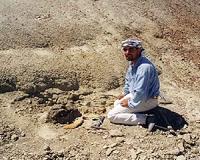| . |  |
. |
Reno NV (SPX) Jul 19, 2010 Scientists studying ancient species migration believe northern birds had the ability to colonise continents that southern species lacked. The research, published in Ecography, reveals how the ancient 'land bridge' of Panama, which first connected North and South America, caused an uneven species migration, leading to a new understanding of species diversity today. The continents of North and South America were historically isolated until they were abruptly joined three million years ago through the tectonic uplift of Central America and the formation of a land corridor in modern day Panama, creating a land bridge. "This connection allowed an unprecedented degree of intercontinental exchange between species that had been isolated for millions of years," said lead author Brian Tilston Smith from the University of Nevada. "However the relatively poor fossil record has prevented us from understanding how the land bridge shaped New World bird communities." Using molecular data and phylogenetic evidence from 11 orders, 34 families, and over 100 genera of bird species the team applied a 'molecular clock' to estimate the historical timing of the migration, giving a unique insight into how the ancient history of American bird migration led to present day species diversity across the equator The results reveal that while ancient birds could fly most species did not cross the water between the two isolated continents, so were subject to the same constraints as their land based mammalian counterparts. The land bridge was therefore crucial in facilitating cross continental migration. "This inter-continental migration was far from even. While within the tropics around the equator exchange was equal in both directions, between the temperate zones of North and South America it was not," said Smith. "Avian lineages from the northern Nearctic regions have repeatedly invaded the tropics and radiated throughout South America. In contract species with South American tropical origins remain largely restricted to the confines of the tropical regions." Existing studies show that in mammals 50% of modern South American species have Northern origins whereas only 10% of species from the North originated in the South. The team found that this pattern is also reflected in birds. When considering the perching birds oscine and suboscine the team found that despite having northern ancestral origins, 55% of New World oscine species now breed in South America, many of them in tropical habitats. In contrast, only 2.4% of suboscines have secondarily adapted to North American temperate zone habitats. "Our study suggests the formation of the panama land bridge was crucial for allowing cross continental bird migration," concluded Smith. "We believe that the ability of species to colonise and radiate across this area represents an important and underappreciated factor to the distribution of species around the equator."
Share This Article With Planet Earth
Related Links University of Nevada, Reno Darwin Today At TerraDaily.com
 Fossil Find Puts A Face On Early Primates
Fossil Find Puts A Face On Early PrimatesAnn Arbor MI (SPX) Jul 19, 2010 When paleontologist Iyad Zalmout went looking for fossil whales and dinosaurs in Saudi Arabia, he never expected to come face-to-face with a significant, early primate fossil. But the skull he stumbled upon provides new insights into what the last common ancestor of apes and monkeys may have looked like and when the two lineages went their separate ways. Zalmout and colleagues at the ... read more |
|
| The content herein, unless otherwise known to be public domain, are Copyright 1995-2010 - SpaceDaily. AFP and UPI Wire Stories are copyright Agence France-Presse and United Press International. ESA Portal Reports are copyright European Space Agency. All NASA sourced material is public domain. Additional copyrights may apply in whole or part to other bona fide parties. Advertising does not imply endorsement,agreement or approval of any opinions, statements or information provided by SpaceDaily on any Web page published or hosted by SpaceDaily. Privacy Statement |